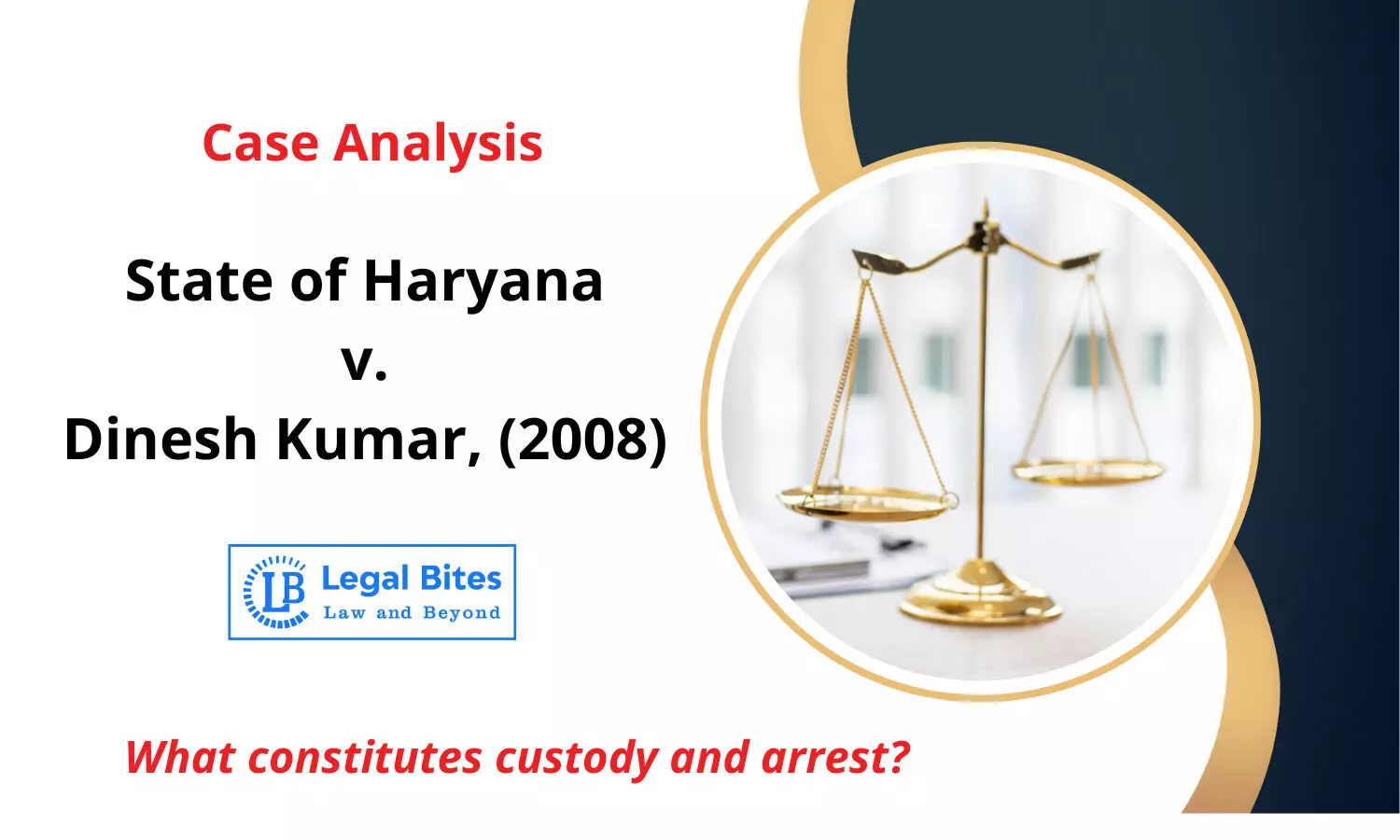Case Analysis: State of Haryana v. Dinesh Kumar, (2008) | Arrest and Custody
The Supreme Court suggested that Section 46 of the Code of Criminal Procedure might provide the primary guidance on the definition of an arrest.;

The Supreme Court suggested that Section 46 of the Code of Criminal Procedure might provide the primary guidance on the definition of an arrest. Case Title: State of Haryana v. Dinesh KumarCitation: AIR 2008 SC 1083Petitioner: State of Haryana & Ors.Respondent: Dinesh KumarJudges: Justice C.K. Thakker, Justice Altamas KabirDate of Judgment: 08/01/2008FactsTwo appeals presented the same issue but received different judgments from two coordinated benches of the same High Court. This led...
The Supreme Court suggested that Section 46 of the Code of Criminal Procedure might provide the primary guidance on the definition of an arrest.
Case Title: State of Haryana v. Dinesh Kumar
Citation: AIR 2008 SC 1083
Petitioner: State of Haryana & Ors.
Respondent: Dinesh Kumar
Judges: Justice C.K. Thakker, Justice Altamas Kabir
Date of Judgment: 08/01/2008
Facts
Two appeals presented the same issue but received different judgments from two coordinated benches of the same High Court. This led to the significant legal question as to what amounts to arrest and custody in terms of criminal proceedings. The cause of the matter was the submission of two applications by Dinesh Kumar and Lalit Kumar, for the position of Constable Driver within the Haryana Police Department. Inquiries related to prior arrests and convictions were mentioned in the application form. Character and Antecedent verification manifested that few of the applicants had not imparted any information about these matters. As a result, the above-mentioned candidate's appointments were denied and thus led to raise objections to their rejection. The first petition by Dinesh Kumar and the second petition by Lalit Kumar stated that they were released on bail without being arrested or in custody.
Issues
- Could the way they appeared before the Magistrate and were released without formal custody be deemed as an arrest?
- Was being detained by an authority with the power to arrest considered an arrest, and could the terms "arrest" and "custody" be used interchangeably?
Laws Applied
- Sections 46 and 439 of the Code of Criminal Procedure
- Article 22 of the Constitution of India
Arguments
Appellants Arguments
The Appellant (Dinesh Kumar and Lalit Kumar) stated that they did not turn themselves in to the police but instead voluntarily went to see the Magistrate with their lawyers respectively, requesting bail. Bail was granted without any delay. This led to meant that they were never caught or taken into custody. Further, it was said that they appeared in court and were released on bail bonds without being arrested. The main point of the argument was that since they were never caught and the case against them was dropped, it must be assumed that there was never a case against them. This meant that by answering "no" to the questions above, they were not hiding anything.
Respondent Arguments
The candidates lied to the selection group on purpose and didn't do what they were supposed to do. Fill out the information asked for on the job application form. When the candidates showed up in court, they were thought to have given themselves over to the custody of the court. And hiding the material facts was providing false evidence.
High Court Decision
The High Court decided that the appellants had not concealed any information while filling out columns 13(A) and 14. As a result, the Court overturned the rejection order issued by the Director General of Police, in Haryana. Subsequently, a separate bench of the same court stated that the applicants had not revealed important aspects and thus were not eligible for the post because they would be unable to carry out their duties honestly.
Judgment
The accused in this case went to meet the Magistrate with the lawyer and requested bail without being taken into formal custody. This point of view was wrong as it appeared to be against Sections 46 and 439 of the Code. Several high courts, including this one, have looked into the question of what an arrest was. Because of this, it is reasonable to think that a regular person would think he was never arrested when he showed up in court and was also quickly released on bail. Things would have been very different if the person in question hadn't been taken out on bond. In this case, the candidates have the benefit of the doubt. The candidates would be considered as hired, but they won't get paid until after this decision is made.
The Supreme Court stated that an individual accused of a crime must be in custody before applying for bail under Section 439 of CrPC. This clarified that detention and restriction in the context of movements, typically by surrendering to the court and complying with its orders result in judicial custody.
Bail can be sought who are in detention awaiting trial and thus helped to make a clear understanding of arrest and custody. The Supreme Court suggested that Section 46 of the Code of Criminal Procedure might provide the primary guidance on the definition of an arrest. The terms arrest" and "custody" cannot be used interchangeably.





